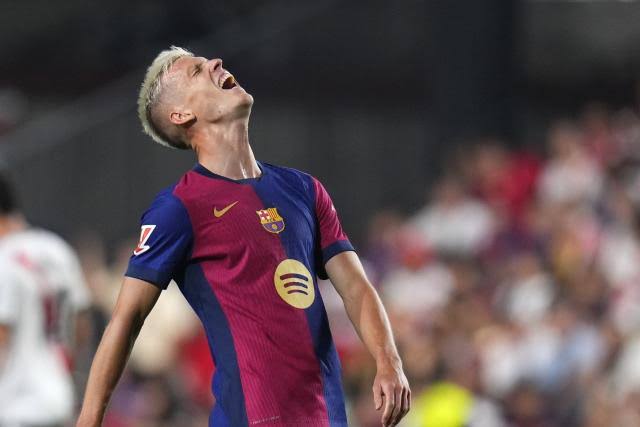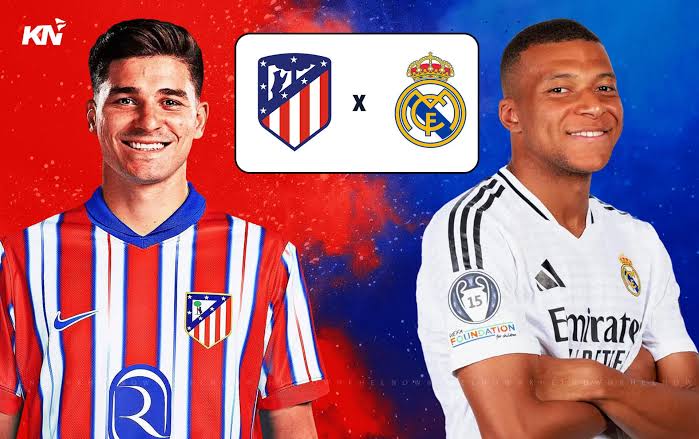Dani Olmo’s Saga: Who Gets Blame, Barcelona or La Liga?

Barcelona midfielder, Dani Olmo. Photo Credit- Yahoo Sports
The Dani Olmo transfer saga has become emblematic of Barcelona’s struggles and La Liga’s broader challenges in retaining its brightest talents. Olmo, a La Masia graduate who left for Dinamo Zagreb in 2014, blossomed into one of Europe’s most versatile and technically gifted midfielders. Despite several transfer windows of speculation linking him to a Barcelona return, the move has never materialized, until eventually this season but even that effort has now been short-lived, leaving fans and analysts questioning why.
This prolonged saga isn’t merely a story about one player but a view through which we can examine the deeper financial, strategic, and institutional problems plaguing both Barcelona and La Liga. This piece explores the roots of the failure, the shared responsibility between the club and the league, and how these challenges are part of a broader, more concerning trend affecting Spanish football.
Dani Olmo and Barcelona
To begin this critique, it is best to explore the relationship that existed between Dani Olmo and Barcelona to achieve a better understanding of the complicated situation that is been addressed. Olmo’s development trajectory should have been the pride of Spanish football and La Masia, yet Barcelona failed to capitalize on the opportunity to bring him back. After excelling at Dinamo Zagreb and later establishing himself as a key player for RB Leipzig, Olmo became one of Europe’s most sought-after talents. His technical qualities, tactical intelligence, and ability to play multiple roles in midfield and attack perfectly align with Barcelona’s identity.
However, despite being an ideal candidate for Barcelona’s rebuild under Hansi Flick, Olmo now remains a free agent in 2025. The reasons for this failure reveal deep dysfunctions within Barcelona’s operations and La Liga’s regulatory framework.
The Dynamics of the Saga: Blame on Barcelona or La Liga?
Barcelona’s Errors
Barcelona’s financial troubles are no secret. Years of reckless spending on overpriced transfers and exorbitant wages left the club saddled with debt exceeding €1 billion. While deals like Coutinho (€160 million) and Griezmann (€120 million) became symbols of wasteful spending, the club neglected opportunities to invest in cost-effective, long-term solutions like Olmo.
Even when Olmo’s transfer fee was reportedly reasonable (€40-50 million), Barcelona’s financial fair play (FFP) constraints prevented them from making a concrete offer. The club was forced to offload players or reduce wages to register new signings, delaying and complicating any pursuit of Olmo.
Barcelona’s transfer dealings have lacked coherence for years. Instead of proactively identifying players who fit their tactical and cultural philosophy, the club often pursued big names to placate fans and boost short-term commercial appeal. Olmo’s versatility and ability to play in multiple positions made him a perfect fit, but he was consistently overlooked for flashier, less suitable signings.
Barcelona’s inability to maintain relationships with La Masia graduates like Olmo highlights systemic issues. Olmo left in 2014 due to limited opportunities in the first team, a recurring theme for many young talents. Unlike clubs like Ajax or Bayern Munich, which foster strong connections with their academies, Barcelona has allowed many promising players to slip away and thrive elsewhere.
La Liga’s Failures
La Liga’s FFP rules, while aimed at promoting financial sustainability, have unintentionally hampered clubs like Barcelona from competing with their European rivals. In contrast to the Premier League’s relatively flexible financial oversight, La Liga enforces rigid caps on wage spending and player registration. These restrictions left Barcelona unable to act decisively in pursuing Olmo, even when they expressed interest.
La Liga’s global standing has waned in recent years. The departures of global icons like Lionel Messi, Cristiano Ronaldo, and Neymar, coupled with the league’s failure to market itself effectively, have reduced its allure. For players like Olmo, who could choose between financially robust leagues like the Premier League or Bundesliga, La Liga’s diminished prestige is a deterrent.
La Liga has also struggled to support its clubs in retaining top talents. While leagues like the Bundesliga pride themselves on developing and holding onto homegrown stars, La Liga has failed to offer incentives or frameworks that encourage players like Olmo to return.
READ ALSO
Who Gets Blame for Man City’s Decline: Players or Manager?
Rashford’s Transfer Dilemma: Stay in United or exit?
Raphinha: From being mocked to Barcelona’s star performer
What the Dani Olmo Saga Reveals About Barcelona’s Broader Challenges
The failure to sign Olmo is just one symptom of a much larger crisis at Barcelona. The club’s struggles are multifaceted, encompassing financial, strategic, and cultural dimensions.
Barcelona’s financial troubles have reached a critical point. While the club activated “financial levers” in 2022—selling off future revenues to fund immediate expenses—this approach is unsustainable. The lack of financial flexibility not only hinders transfers but also affects squad depth and renewal projects.
Moreover, Barcelona’s thin squad has been exposed by frequent injuries to key players like Pedri, Frenkie de Jong, Araujo, and Robert Lewandowski. Without adequate reinforcements, the team has struggled to maintain consistency, particularly in domestic competitions. Barcelona’s youth revolution is admirable but also dangerous. Players like Pedri, Gavi, Alejandro Balde, and Lamine Yamal have shown immense promise, but the lack of experienced leaders in the squad leaves them vulnerable in difficult situations, which is happening now.
Furthermore, Barcelona’s leadership struggles, including the fallout from the Josep Maria Bartomeu era and the challenges facing Joan Laporta’s presidency, have further destabilized the club. Governance issues have hindered decision-making and long-term planning.
Solutions: What Needs to Change?
It is not enough to only criticize, apportion blames on Barcelona and La Liga or even discuss the current challenges affecting the club but to also provide a viable solution that can change the status quo and elevate both Barcelona and La Liga into domination in European football, rather than been marred by controversies.
For Barcelona
The club must prioritize sustainable financial practices, focusing on reducing debt and optimizing revenue streams. Diversifying income sources, such as global sponsorship deals and fan engagement initiatives, can help improve financial stability.
Moreover, Barcelona needs to move away from reactionary signings and focus on players who fit their philosophy and tactical needs. Dani Olmo’s case is a prime example of the type of player they should target consistently. Additionally, rebuilding relationships with former academy players, whether through targeted transfers or ambassadorial roles, can strengthen the club’s identity and talent pool. Not to forget that there should be a balance between young aspiring players and those with much experience in the sport.
For La Liga
While financial oversight is necessary, La Liga must adopt a more flexible, yet competitive FFP framework to help its clubs retain talent and compete internationally. Additionally, La Liga must invest in marketing and broadcasting strategies to restore its global appeal. Highlighting emerging talents and fostering rivalries can help rebuild its image. Furthermore, offering financial incentives for retaining homegrown talent and reinvesting in academies could strengthen La Liga’s identity as a developmental league.
Conclusion
The Dani Olmo transfer saga is a miniature event of Barcelona’s struggles and La Liga’s systemic inefficiencies. While Barcelona’s financial mismanagement and poor strategic planning are significant factors, La Liga’s rigid regulations and declining global prestige have also played a role in this failure.
If Barcelona hopes to regain its former glory and La Liga wants to remain competitive on the global stage, both entities must address their underlying problems. For Barcelona, this means adopting a long-term vision, rebuilding financial stability, and prioritizing sustainable squad development. For La Liga, the focus must be on creating a more flexible and competitive environment that encourages talent retention and growth.
The Dani Olmo saga is more than just a big missed transfer, it is a warning about the dangers of mismanagement, and shortsightedness in modern football. Without meaningful reform, both Barcelona and La Liga risk further decline in an increasingly competitive landscape.




